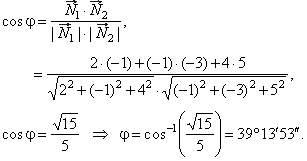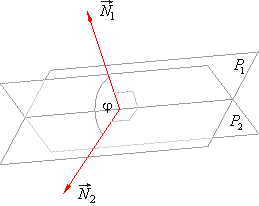|
| Coordinate
Geometry (Analytic Geometry) in Three-dimensional Space |
|
|
Plane
in a three-dimensional (3D) coordinate system |
 Comparison of
the general form and the
Hessian normal form of equations of a plane
Comparison of
the general form and the
Hessian normal form of equations of a plane
|
 The distance of a point to a plane -
plane given in general form
The distance of a point to a plane -
plane given in general form
|
 Angle (dihedral angle) between two
planes
Angle (dihedral angle) between two
planes
|
|
|
|
|
|
|
| Comparison of general form and the
Hessian normal form of equations of a plane
|
| Coefficients,
A,
B
and C,
beside coordinates x,
y
and z, of the general form of equation |
| Ax
+ By
+ Cz
+ D = 0 |
| are the components of the normal vector
N
= Ai + Bj
+ Ck, while in the Hessian’s equation |
| x
· cosa
+ y · cosb
+ z · cosg
-
p
= 0, |
| on that place, there are components (the direction cosines) of the unit vector
N°
of the same vector. |
 |
| Thus, to convert from general form to the Hessian normal form, divide the general form of equation by |
 |
taking the sign of the square root opposite to the sign of
D, where
D
is not 0 |
|
 |
|
| The distance of a point to a plane -
plane given in general form
|
| Let
replace in the Hessian formula for the distance d
= x0
· cosa
+ y0 · cosb
+ z0 · cosg -
p, the direction
cosines and the length of the normal p, by coefficients of the general form,
to obtain |
|
|
| the formula for the
distance of a point to a plane given in the general
form. |
|
| Angle (dihedral angle) between two
planes
|
| The angle subtended by normals drawn from the origin to the first and second plane, that is, the angle which
form
the normal vectors of the given planes is |
|
|
| the
angle between two planes. |
| If planes are parallel normal vectors are collinear that is, |
| N1
= lN2
<=> j
= 0°, |
| and if planes are orthogonal, then their normal vectors are orthogonal too, so their scalar product is zero, |
| N1 · N2
= 0 <=> j
= 90°. |
|
| Example:
Find the angle between planes,
P1
::
2x -
y + 4z -
3 = 0 and
P2
:: -x -
3y + 5z + 6 = 0.
|
| Solution:
Thus, |
| N1 =
2i
-
j + 4k and
N2
=
-i
-
3j + 5k,
then |
 |
|
 |
|
|
|
|
|
|
|
|
|
|
|
|
|
|
| Pre-calculus contents
J |
|
|
 |
|
| Copyright
© 2004 - 2020, Nabla Ltd. All rights reserved. |